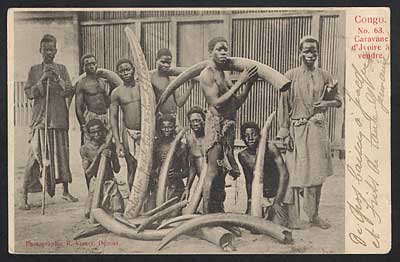
Section One
Central African Peoples through the Eyes of Western Photographers

In most parts of Africa, the colonial period lasted from 1885 to 1960. In 1885, Léopold II, king of the Belgians, claimed extensive territories in central Africa as his private holdings and established the Congo Free State. In 1908, after worldwide protests castigating labor abuses and atrocities committed against the African population, the Belgian government annexed the king's private holdings, which then became the Belgian Congo. To the north of the Congo Free State, France established French Equatorial Africa (A.E.F.). To the east, Germany took over the kingdoms of Rwanda and Burundi, but lost them to Belgium as a result of the First World War. In the south, Portugal occupied Angola.
Throughout this period photography was used to describe and classify peoples under colonial domination and to record information about African architecture and art, dress and adornment, body decoration, ceremonies and rituals. Today, many of these photographs--even considering the circumstances under which they were taken--have become valuable historical documents of African ways of life. However, they are equally important as primary evidence of commonly held Western beliefs about Africans. Photographers tended to focus on themes that often reinforced erroneous notions of an "exotic" or "savage" Africa, visually evoking stereotypes about Africans. Some of these stereotypes--which could be traced to the earliest Western encounters with Africans along the coast in the 16th century--were celebratory; others were derogatory, racist and deeply painful. Seen from our contemporary perspective, many of the perceptions conveyed by the imagery were "out of focus": viciously wrong and permanently damaging.

Besides documenting Africans and African life, much of the photographic activity in central Africa served to popularize the colonial venture. The building of the colonial infrastructure and successful economic exploitation of ivory, rubber and later minerals were common themes. Africans, whom the colonials saw as culturally inferior, were to be Christianized and educated in what has become known as the "civilizing mission." Missionary activities and educational efforts are portrayed in the imagery, which celebrated colonial achievement. Many of the photographs exhibited here are aesthetically and technically compelling, which is one of the reasons they were widely reproduced. They formed an image world that focused on narrow, repetitive themes. These pictures left an indelible mark on the Western imagination, creating representations of central Africa that have had tremendous staying power. It is, however, important to go beyond their nostalgic beauty to reveal the underlying concepts that informed their creation and were promulgated by their publishers and understood by their viewers.
Pictured above
Caravan with ivory, French Congo
Robert Visser (1860-1937)
c. 1890-1900, postcard, collotype
Publisher unknown, c. 1900
Postmarked 1912
Eliot Elisofon Photographic Archives
National Museum of African Art
Smithsonian Institution
CF 16-6